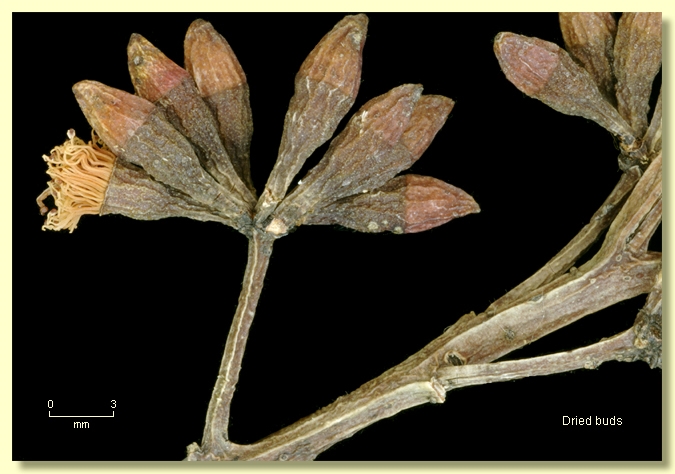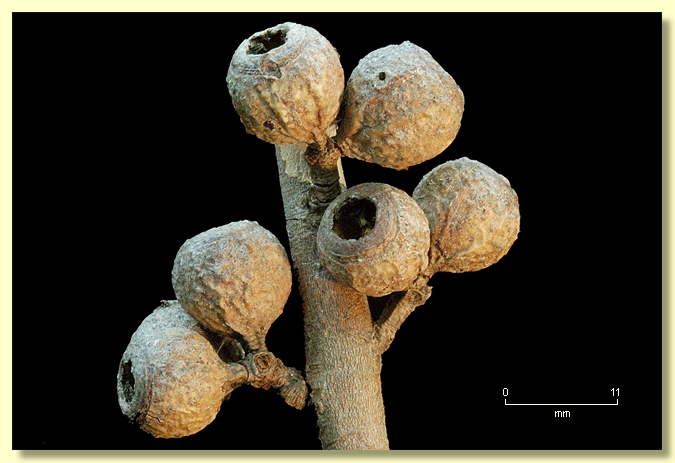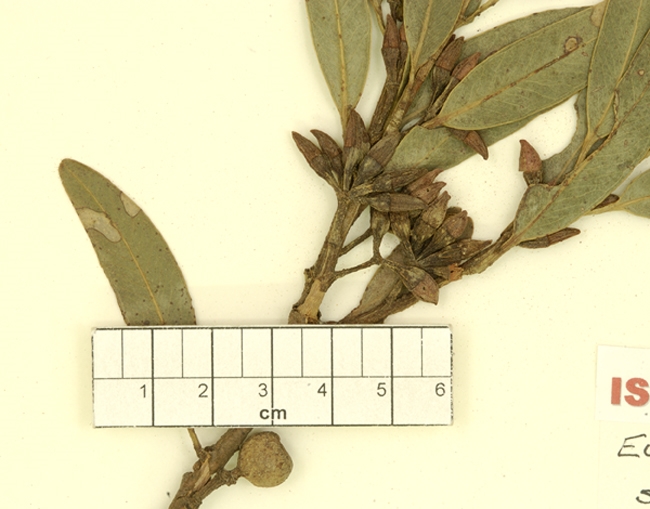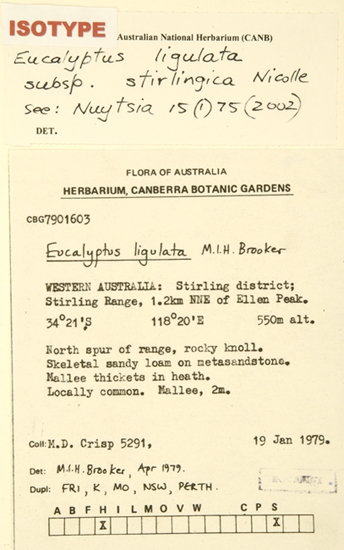Eucalyptus | Eucalyptus | Longistylus | Frutices | Calcicolae
Euclid - Online edition
Eucalyptus ligulata subsp. stirlingica
Mallee to 2–3 m tall. Forming a lignotuber.
Bark smooth, pale whitish grey to greenish grey over pink-brown.
Branchlets angular; lacking oil glands in the pith, glabrous.
Juvenile growth (coppice or field seedlings to 50 cm): not seen.
Adult leaves alternate, petioles 0.8–1.4 cm long; blade narrowly elliptical to narrowly lanceolate, 3.5–7.5 cm long, 0.7–1.8 cm wide, base tapering to petiole, margin entire, apex pointed, slightly glossy, green to bluish green, side-veins greater than or less than 45° to midrib, reticulation sparse to moderate, intramarginal vein close to margin, oil glands irregular, island, or apparently absent.
Inflorescence axillary unbranched, peduncles 0.5–1 cm long, buds in umbels of 9 to13, with pedicels 0.2–0.4 cm long). Mature buds elongated ovoid to broadly fusiform (1–1.4 cm long, 0.4–0.5 cm wide), with ca 8 shallow longitudinal ribs, scar absent, the single operculum conical and longer than the base of the bud, outer stamens erect, inner inflexed, anthers oblong, versatile, dorsifixed, dehiscing by longitudinal slits that are not confluent apically, style long and straight, stigma blunt, locules 3, the placentae each with 2 vertical rows of ovules. Flowers white.
Fruit pedicellate (pedicels 0.1–0.3 cm long), cupular to barrel-shaped or truncate-globose, shallowly ribbed or ± smooth, 0.7–1.1 cm long, 0.8–1 cm wide, disc usually level or raised, valves 3, enclosed.
Seeds blackish, 3–4.5 mm long, obliquely pyramidal, dorsal surface curved, minutely wrinkled, ventrally ridged, hilum terminal.
Cultivated seedlings (measured at ca node 10): not grown beyong node 4. Cotyledons reniform; stems rounded to square in cross-section, scabrid for lower 4 internodes, leaves opposite, sessile and amplexicaul, dull, green, discolorous to this stage.
Flowering has been recorded in March and October.
Eucalyptus ligulata is a mallee species endemic to Western Australia, mainly east of Esperance in the Cape Le Grand – Lucky Bay area and at Cape Arid but also further west in the Stirling Range. The bark is smooth and the adult leaves slightly glossy, green or sometimes bluish green, buds occur in axillary umbels and are conspicuously ribbed whilst the fruit are moderately large, barrel-shaped to cupular or hemispherical to 1.3 cm long and 1.4 cm wide with conspicuous ribs.
Eucalyptus ligulata belongs in Eucalyptus subgenus Eucalyptus series Calcicolae, a small group characterised by smooth bark, prominently ribbed buds with a single operculum (hence no operculum scar), more or less cuboid anthers that shed pollen by two separate slits, ovules arranged in two rows on the placenta, seedling and juvenile leaves opposite, sessile and stem-clasping at the lower nodes then petiolate and alternate, fruit ribbed and seed obliquely pyramidal in shape.
Eucalyptus ligulata is closely related to E. calcicola from the south-western coastal area from Boranup to near Bremer Bay on limestone dunes and headlands and which has broader and very glossy green seedling and juvenile leaves, seven buds in the inflorescence (nine to 13 buds in E. ligulata) and wider more prominently ribbed buds and fruit.
Eucalyptus ligulata has two subspecies:
E. ligulata subsp. ligulata
Characterised by buds with the operculum more or less equal in length to the hypanthium (base of bud), mature bud pedicels 0.4–0.8 mm long and more prominently ribbed fruit 0.9–1.4 cm wide, often with the disc sloping inwards. Occurs from Cape Le Grand to Lucky Bay and Cape Arid where found on moist granitic sand around inselbergs, peaks and outcrops.
E. ligulata subsp. stirlingica
Buds have the operculum longer than the hypanthium, mature bud pedicels 0.2–0.4 cm long and slightly smaller fruit (0.8–1 cm wide) which are less prominently ribbed, some almost smooth, and with the disc usually level or raised slightly. Occurs only in the Stirling Range where found on sedimentary-derived sandy soils around the foothills and also on some ridges and upper slopes.
Eucalyptus ligulata: Latin ligulatus, strap-like, referring to the peduncles.
subsp. stirlingica: referring to the Stirling Ranges, where this subspecies is found.













